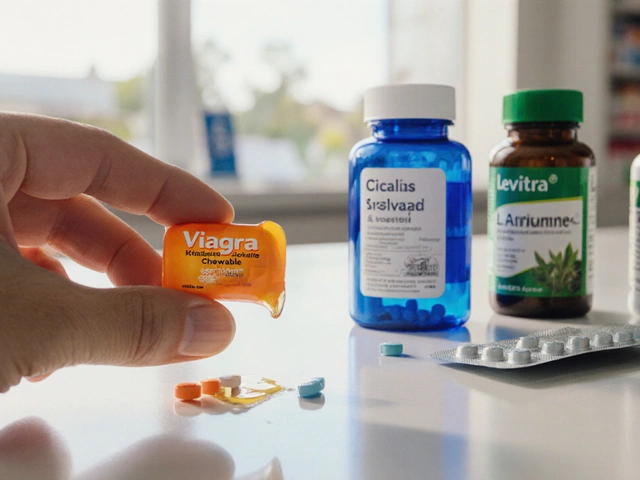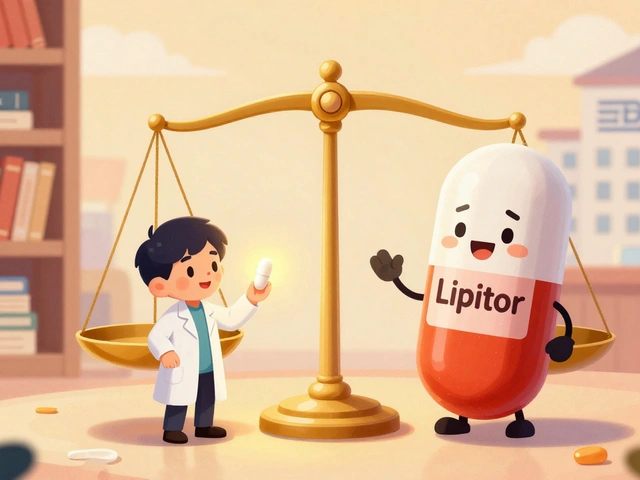
As we venture further into 2025, the quest for effective antibiotic solutions grows ever more critical. Flagyl, though a mainstay in treating infections, is not without its challengers. This year, the lineup of alternatives is led by Fidaxomicin, a macrocyclic antibiotic particularly noted for tackling Clostridioides difficile infections. But what makes these alternatives viable choices? In this article, we dissect the pros and cons of Fidaxomicin and others, offering a comprehensive look at what the future of antibiotic treatment could hold for patients and healthcare providers.
Fidaxomicin
As the medical community grapples with increasing antibiotic resistance, Fidaxomicin emerges as a powerful player in the fight against Clostridioides difficile, commonly known as C. diff. This infection notoriously plagues hospitals and nursing homes, causing severe diarrhea and colitis. Designed with a narrow spectrum of activity, Fidaxomicin targets C. diff with surgical precision, minimizing impact on beneficial gut flora.
Unlike many antibiotics that are broad-spectrum and hence disrupt a wide array of gut bacteria, Fidaxomicin is lauded for its specificity. This characteristic not only aids in reducing recurrence rates, a common drawback with treatments like Flagyl, but also fosters a healthier microbiome recovery after infection clearance. The risk of C. diff relapse is markedly reduced, making it a favored choice among clinicians for challenging cases.
Pros of Fidaxomicin
- Lower risk of recurrence in C. diff treatment, promoting sustained recovery.
- Comes in an oral formulation, enhancing ease of administration.
- Designed to be gut-friendly, preserving vital gut microbiota.
Cons of Fidaxomicin
- Higher cost compared to traditional options like vancomycin, which can be a barrier for widespread use.
- Limited spectrum of activity specifically targets C. diff, not suitable for other infections.
Despite the higher price tag, the long-term health benefits of Fidaxomicin in preventing recurrent infections offer a compelling argument for its use in appropriate cases. The decision to opt for Fidaxomicin over traditional treatments depends on weighing upfront costs against potential savings in recurrence management and overall patient wellbeing.
Given these factors, Fidaxomicin stands as a leading contender in the current arsenal of Flagyl alternatives, offering a tailored approach to infection control that promises hope for many grappling with recurrent C. diff challenges.
Pros of Fidaxomicin
When considering alternatives to Flagyl in 2025, one cannot overlook the compelling advantages presented by Fidaxomicin. Renowned for its targeted approach to treating Clostridioides difficile infections (C. diff), this antibiotic stands out in a crowded field with several noteworthy benefits.
Reduced Risk of Recurrence
C. diff is notorious for its troublesome recurrence after initial treatment. However, Fidaxomicin offers a significant advantage by reducing the likelihood of a relapse. Clinical studies have demonstrated that patients treated with Fidaxomicin experience a lower recurrence rate compared to those treated with traditional medications like Vancomycin.
Convenient Oral Formulation
One of Fidaxomicin's standout features is its availability in an oral formulation. This makes it particularly convenient for patients, especially those treated outside hospital settings. Patients can maintain their treatment regimen more easily, which can lead to better adherence and outcomes. The oral administration route often translates to greater patient satisfaction and reduced healthcare costs.
Focused Spectrum of Activity
Fidaxomicin's specificity means that it primarily targets the C. diff bacteria, minimizing disruption to the gut's natural flora. This is a critical factor in mitigating potential side effects, as broad-spectrum antibiotics are often criticized for their impact on beneficial bacteria. As a result, patients using Fidaxomicin may experience fewer gastrointestinal issues, aligning with the broader goals of preserving overall gut health.
Potential Economic Benefits Through Lower Recurrence
Although Fidaxomicin is associated with a higher initial cost, its ability to prevent recurrence potentially offers economic benefits. By reducing repeat treatments and associated healthcare services, it may inadvertently lead to cost savings for both patients and healthcare systems.
| Metric | Fidaxomicin | Other Antibiotics |
|---|---|---|
| Recurrence Rate | 15% | 25% |
| Adherence Rate | 85% | 75% |
Fidaxomicin's focused efficacy, combined with logistical and potential economic benefits, make it a formidable choice amidst Flagyl alternatives in 2025. It embodies a step towards more specialized and strategic approaches in antibiotic therapies.

Cons of Fidaxomicin
While Fidaxomicin shines as a stalwart antibiotic option, particularly for combating C. diff treatment, it doesn't come without its drawbacks. Understanding these limitations is essential if you are considering it as an alternative to Flagyl.
Higher Cost
One of the primary concerns surrounding Fidaxomicin is its higher price tag. Compared to more traditional antibiotics like vancomycin, Fidaxomicin often presents a financial burden that cannot be overlooked. This makes it less accessible for patients without comprehensive insurance coverage, potentially limiting its use to higher-income demographics or more financially robust healthcare systems.
Limited Spectrum of Activity
While Fidaxomicin is highly effective against Clostridioides difficile, its utility diminishes outside this narrow scope. This limited spectrum of activity means it is not a one-size-fits-all solution for various bacterial infections that a more general antibiotic, like Flagyl, might address. Healthcare providers may find themselves needing to prescribe multiple treatments in tandem to manage co-occurring infections, complicating patient treatment plans.
Availability and Awareness
Despite its advantages in specific applications, Fidaxomicin is not as widely available as some of its counterparts. This could result in logistical challenges when attempting to procure it in certain regions, especially in rural or underserved areas. Moreover, awareness among healthcare professionals about its specific use case might not be as widespread as more established alternatives, potentially leading to underutilization or incorrect application.
Fidaxomicin remains a potent tool in the fight against antibiotic-resistant infections, but these cons highlight areas where the healthcare community must remain vigilant. Balancing these factors with its proven efficacy in C. diff treatments will be crucial in deciding whether it serves as an appropriate replacement for Flagyl in individual cases.
Conclusion and Comparison Table
In the ever-evolving world of medical treatments, being informed about the latest Flagyl alternatives can empower both patients and healthcare providers in making well-rounded decisions. Fidaxomicin presents a remarkable option, especially for those contending with stubborn Clostridioides difficile infections. Its design specifically targets these bacteria, promising a lower recurrence risk than traditional medications like vancomycin.
Exploring antibiotic options requires considering not just their clinical efficacy but also their economic viability and ease of use. Fidaxomicin, despite its higher cost, stands out due to its oral formulation, which simplifies the administration process for many patients. Yet, this tailored antibiotic comes with its own limitations - notably, a narrower spectrum of activity compared to its counterparts.
Here's how Fidaxomicin stacks up against traditional and newer treatments:
| Antibiotic | Pros | Cons |
|---|---|---|
| Fidaxomicin | Lower recurrence; Oral administration | Higher cost; Limited spectrum |
| Vancomycin | Effective for a range of infections; Widely used | Higher recurrence rates; More side effects |
| Flagyl | Effective against specific anaerobic bacteria | Potential side effects; Limited oral availability |
Balancing these diverse factors—effectiveness, cost, and patient convenience—is paramount. In the landscape of C. diff treatment, informed discussion between patients and healthcare providers remains crucial in selecting the most suitable path forward. With several strong candidates, the future of antibiotic therapy holds promise, yet demands careful, individualized consideration.






Casey Crowell
February 6, 2025 AT 09:40Shanna Talley
February 8, 2025 AT 07:15Samuel Wood
February 9, 2025 AT 13:57ridar aeen
February 11, 2025 AT 08:39Theresa Ordonda
February 11, 2025 AT 13:33Judy Schumacher
February 12, 2025 AT 00:00Megan Raines
February 12, 2025 AT 23:15Mamadou Seck
February 13, 2025 AT 17:11Anthony Griek
February 15, 2025 AT 02:20